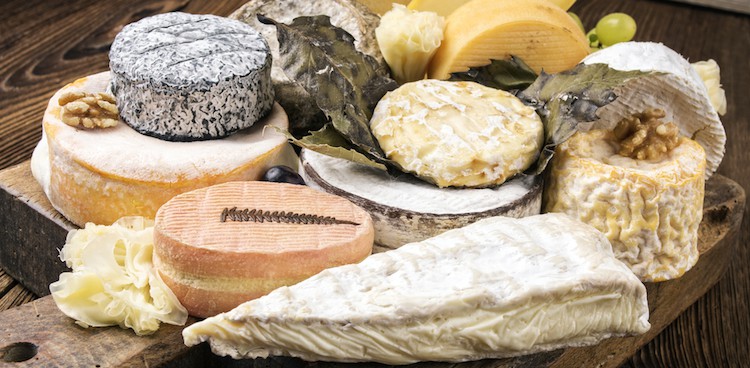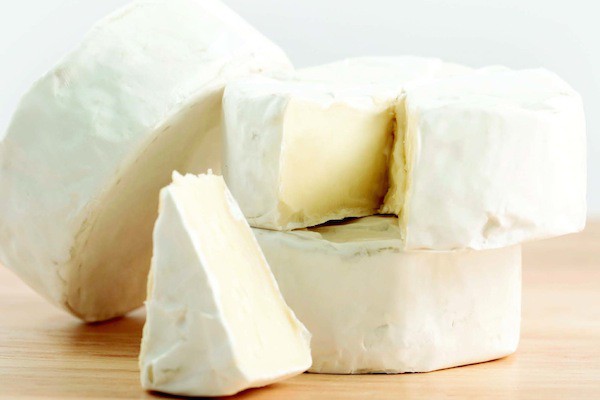
We talk about stinky cheese all the time here at culture, but sometimes it’s best to go back to the basics. What’s the deal with stinky cheese? What are the different kinds, and how should you eat them? Sue Conley and Peggy Smith from Cowgirl Creamery answer these burning questions.
1. Washed-rind cheeses smell stronger than they taste.
Washed-rind cheeses might be the stinkiest of them all, but the taste is comparatively mild. This is mostly due to the fact that the brine (or beer or water) is rubbed on the rind and all the stinky bacteria growth mostly stays on the rind. That means your rind is going to taste quite funky but the paste remains much milder. The most well known washed-rind cheese is the French Époisses, which gets its stink from marc—a local pomace brandy made from the leftovers of wine production. Despite the strong smell, the taste is creamy and relatively mild. You’ll get hints of bacon and custard in addition to some earthy and nutty notes.
Cowgirl Creamery features a cheese similar to Époisses, called Red Hawk, which also has the added distinction of being a triple cream. A triple-cream cheese adds extra cream into the mix before the curd is formed, bringing the butterfat content up to 75 percent or more. That definitely helps add to the creaminess and balances out the strong smell of the rind.
2. Blue cheeses are pierced with needles to spread the mold throughout.
While washed-rind cheeses might have surprisingly mild interiors, blue cheeses are moldy and strong through and through. The soft, open texture of blue cheeses gives the mold the chance to grow in those open areas, but cheesemakers like to ensure even mold growth throughout the whole wheel. To do this, they pierce the cheese before setting the cheeses aside to age, and the spaces opened up by the piercing allow the mold to do its thing. The most famous example of this, again, is a French cheese: Roquefort. But many other blues follow suit.
Some cheesemakers will even direct the growth of the mold in an unusual way, like Jersey Blue, produced by Willi Schmid in Switzerland. The production process includes carefully hand ladling curds into their molds, which create pockets where the mold develops. Rather than the usual blue veins dotted throughout, Jersey Blue features lightning bolt like streaks of mold.
3. Thank bacteria for the stink.

Cheesemakers add bacteria to Roquefort to get the look, taste, and smell. Photo Credit: Africa Studio | Shutterstock
We’re often afraid of bacteria invading our food, but the truth is that we have bacteria to thank for making stinky cheeses smell and taste like they do. For washed-rind cheeses it’s most often Brevibacterium linens, which lends the cheese a reddish or orange color and makes it stink. Other bacteria commonly found in stinky cheese are Penicillium roqueforti and Penicillium camemberti (it should be pretty easy to guess which cheeses those bacteria belong to). These bacteria are relatives to the penicillin we use to treat infections today, but you really shouldn’t use either one for anything but cheese. Remembering that there is bacteria in your cheese should help you remember that cheese is almost a living entity in its own right that changes as it ages—a lot like us!
4. For a stinky cheese plate: start with a soft washed-rind, move onto an aged, and end with blue cheese.
When you put out a cheese plate, you typically want to start with whatever has the mildest taste and end with the strongest (invariably a blue). That way, you won’t eat the blue cheese and have your taste buds so overloaded with sensation that the other cheeses taste differently. If you want to host a party with a bunch of stinky cheeses, start with the washed-rind cheeses first, move onto to aged washed-rind cheeses (like Cowgirl Creamery’s Wagon Wheel), and end with the powerful blues.
5. Pair something sweet with your stinky cheese.
What should you pair with your all-stink, all-the-time cheese plate? Fruits, preserves, and honey are all great options. In fact, if you want to go all out, you can take the time to pair different types of honey with different types of blue cheese and really impress your friends.
On the alcohol front, white wines with some sweetness and richness are great choices. The sweetness of the wine helps to offset the bite of a blue. Just make sure it’s a full-bodied enough white to stand up to the taste of the cheese. On the red front, look for something with lots of fruit and body and not so many tannins. Or even a Trappist-style beer! Remember, monks used to make beer and washed-rind cheeses, so the two were practically made to go together.
Feature Photo Credit: “Cheese Plate” by HLPhoto | Shutterstock







